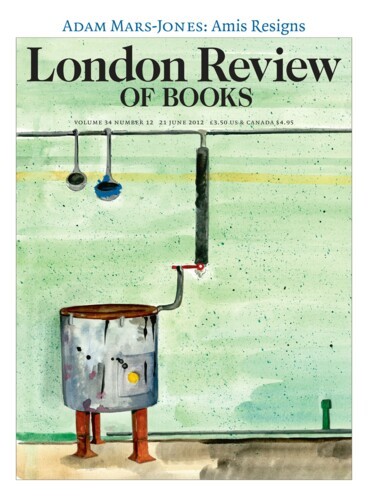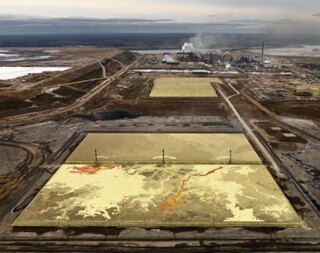Since the mid-1980s, Edward Burtynsky has been photographing landscapes that have been transformed by human intervention. In his early work – a series on mines and one on railway cuttings from 1985; one on quarries from the early 1990s – the human presence took the form of a geometric intrusion into the natural world: regular slabs cut from granite, rail-tracks slicing across a mountainside. The images verge on the abstract, partly because industrial subjects like these tend to have angular shapes, but also because they are often framed without any visible horizon or surrounding context, making them harder to read as landscapes. Your attention first focuses on the large-scale forms that occupy the bulk of the image: it’s only later that you notice scattered signs of human involvement – ladders, cranes, hoses – which are dwarfed by the imprint they have helped make on the environment.
In much of his subsequent work, the human impact is more patently damaging. The Tailings series of 1995-96 showed the noxious run-off from metal extraction in Burtynsky’s native Canada: streams of cadmium red weaving across the land like lava, or uranium tailings coating the ground with a white residue. In 2010, he took several photographs of the Deepwater Horizon oil spill from a helicopter above the Gulf of Mexico: the human presence – boats and drilling rigs – is tiny compared with the vast slick that occupies most of the image, in some cases creating a marbled pattern on the water’s surface, in others diffusing through it like ink. These images are included in Oil, an exhibition at the Photographers’ Gallery (until 1 July) which consists of around thirty large-format pictures taken between 1997 and 2010. Most are drawn from a much larger collection of images published in a book of the same name in 2009; there is now even an iPad app.
The show is divided into three sections referring to different phases in oil’s life cycle as a commodity. In the first, ‘Extraction and Refinement’, we see the vast technological apparatus required to get the stuff out of the ground and process it for use: a field of pumpjacks stretching to the horizon in the California desert; a set of shiny pipelines winding through a forest in Alberta; a maze of tubes and girders at a New Brunswick refinery. In the second section, ‘Transportation and Motor Culture’, we see row upon row of new cars, covered in white vinyl to protect their paintwork; a spiralling exit ramp from a bridge in Shanghai; the tangled concrete ribbons of a freeway intersection in Los Angeles. The images in the final room, ‘The End of Oil’, gesture to a number of finalities: oil tankers being broken up on the sands of Chittagong; a ‘graveyard’ for military aircraft in Arizona, where phalanxes of jets and bombers stand neatly parked. In the abandoned, rusting derricks and oily puddles of the Socar field in Azerbaijan, the 19th-century dawn of industrial-scale extraction seems to merge with an apocalyptic future in which all that is left of humanity is lingering contamination.
The images are stunning, and disorienting; they provoke both awe and a sense of ecological horror. Alberta Oil Sands #6 (2007, shown above) shows a massive installation for extracting oil from tar sands. The picture is dominated by two huge yellow rectangles that seem like abstract forms drawn onto the landscape – but then you realise they are vats of sulphur hundreds of metres wide and hundreds more long. In Burtynsky’s 2004 aerial view of a refinery on the coast at Pasadena, Texas, a sense of scale is disconcertingly elusive: the massive tanker in the foreground makes the dozen or so round white fuel containers on land look like game counters, while the refineries in the background seem to have been miniaturised. At this point, we realise that any actual humans are too small even to register in this scene: they have disappeared into the complex apparatus of tubes, pipes, rails and roads with which they have covered the earth.
Something similar is at work in Highway #1 (2003), where we see a set of looping concrete roadways so bewilderingly complicated it seems hard to imagine anyone deliberately designing them that way. Burtynsky reports trying to shoot the intersection from the ground, but ‘it just didn’t register’, so he hired a helicopter – his first venture into aerial photography. The scene is framed in a way that allows the knot of roads to remain abstract. Distance helps: the camera is far enough away to capture a sense of a pattern or system that exceeds the human scale, but not far enough for us to reconceive the pattern as a map or diagram. We are left with the forms, and a feeling that, though there is clearly some order at work here, we cannot grasp it.
With this image Burtynsky made another important move: in much aerial landscape photography the bird’s-eye view is what produces the estranging effect, but here the angle of vision is oblique. The tilting of the perspective towards the ground propels us into the scene, inducing vertigo – and a vague sense of complicity. This isn’t the abstract, Olympian vantage-point of satellite imagery, but something more ambiguous. The angle makes it clear that the gaze is located within the same three-dimensional landscape it is viewing. Unlike that of a drone pilot zooming in on a Yemeni village, or someone browsing a foreign city through Google Earth, the gaze is involved, yet also distanced from what it sees. The gaze isn’t incurious, but it isn’t immediately clear what the objects of its curiosity are: the pattern made by the roads, or the purposes they serve? The shape of the sulphur vats or the fact that they’re there at all?
Ambiguities of this kind recur in Burtynsky’s work. They seem to be the result of a deliberate strategy, as he pushes us to find some equilibrium between aesthetic appreciation and guilt at admiring such alluring representations of damage. But at times the ambiguity disguises conceptual difficulties or actual conflicts. Burtynsky reports having an ‘oil epiphany’ in 1997: he realised the ‘vast, human-altered landscapes that I pursued and photographed for over twenty years were only made possible by the discovery of oil’. This seems disingenuous: Burtynsky would have been 18 at the time of the oil shock of 1973, and can hardly not have known for some time that oil is central to modern capitalist civilisation. His statement may just be intended, though, to provide a tidier point of origin for his oil project than the subject itself – ubiquitous, indissociable from our lives – can offer.
Of course, oil’s omnipresence is one of the things that makes it hard to depict, and Burtynsky’s images can’t be expected comprehensively to document its countless uses and effects: he calls them ‘notations’. Even so, there is something troublingly partial about the view we are given here. There is no sense that oil has been a source not only of ecological harm, but also of war, and of vast distortions of power and wealth. It’s strange that the Middle East doesn’t feature at all, despite accounting for at least a third of global production and half of proven reserves. The images in the exhibition’s final room – the broken hulls of ships, the mothballed jets, the sea of used tyres – provoke a different kind of unease. For what these ruined and discarded objects show is not the end of oil, but the obsolescence of these particular machines; not the exhaustion of a civilisation addicted to petroleum, but its oblivious self-perpetuation.
Send Letters To:
The Editor
London Review of Books,
28 Little Russell Street
London, WC1A 2HN
letters@lrb.co.uk
Please include name, address, and a telephone number.


